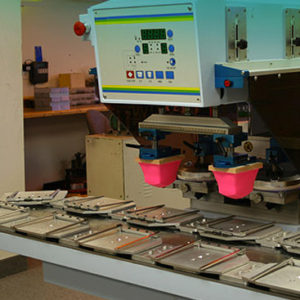Pad Printing
 The pad printing process has its origins in screen, rubber stamp and photogravure printing processes. It is a unique process due to its ability to print on three-dimensional objects and at compound angles. The image to be transferred is etched into a printing plate commonly referred to as a cliche. The cliché can be a photopolymer plate or a steel plate. A pad made of silicone rubber is used to transfer the image to a substrate.
The pad printing process has its origins in screen, rubber stamp and photogravure printing processes. It is a unique process due to its ability to print on three-dimensional objects and at compound angles. The image to be transferred is etched into a printing plate commonly referred to as a cliche. The cliché can be a photopolymer plate or a steel plate. A pad made of silicone rubber is used to transfer the image to a substrate.
Once mounted in the machine, the cliche is flooded with ink. The surface of the cliche is then doctored clean, leaving ink only in the image area. As solvents evaporate from the image area the ink’s ability to adhere to the silicone transfer pad increases. The pad is positioned directly over the cliche, pressed onto it to pick up the ink, and then lifted away. Then the pad is shifted and pressed down onto the substrate, conforming to its shape and depositing the ink in the desired location.
Pad printing is limited to relatively small images compared with screen printing. Pad-printable image area is usually less than 100 square inches. There are two basic types pad printing machines: open and closed. Open systems feature an ink trough or basin of some type that is at least partially exposed to the air. Closed systems have “ink cups” that keep the ink from coming into contact with the air. In addition to standard solvent-borne pad printing inks, there are baking inks, oxidizing inks and UV-cured inks that are used in pad printing.
Steel-backed photopolymer plates are preferred as clichés. Polymer thickness ranges from 30 to 50 microns. Photopolymer plates are available which can withstand more than 100,000 impressions, with an image resolution that meets or exceeds that of etched steel clichés. These plates are also used in letterpress printing and are generally based on nylon chemistry. They may be developed with water or alcohol. Manufacturers of photopolymer plates include those shown here. One of the finest examples of pad printing is printing on pimpled surface of golf balls.
Copyright © 2007-2008 Savla Associates

